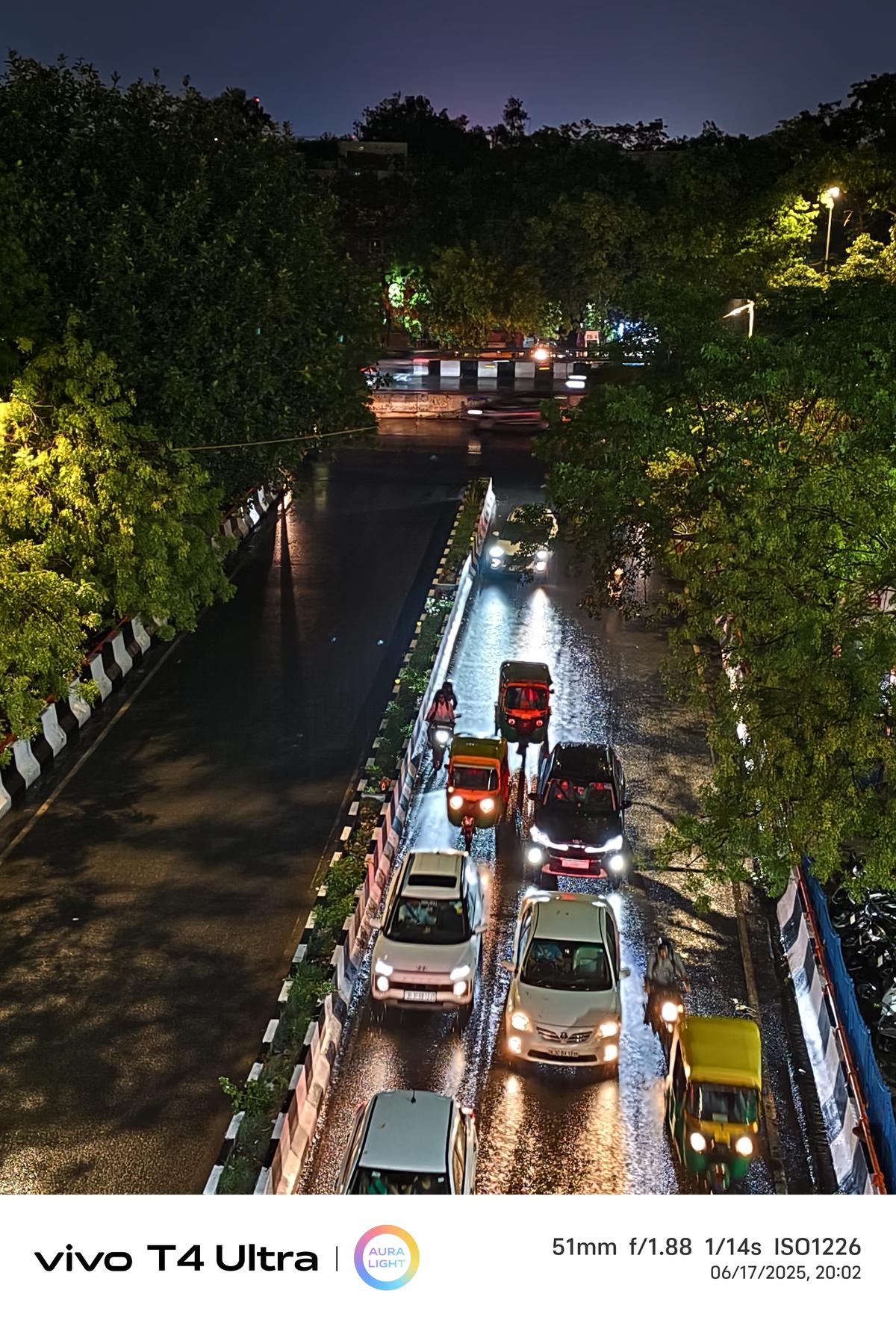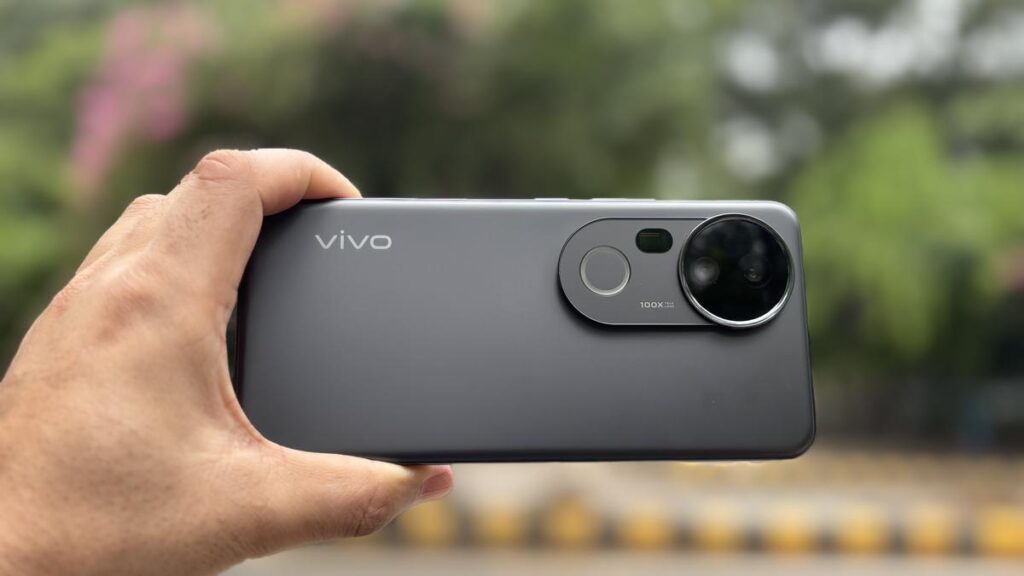Lately, a new segment is building up tempo, one that sits neatly between budget and flagship territory. I’m talking about the increasingly competitive ₹35K–₹40K segment. In the last few months alone, this space has welcomed a slew of performance-first devices aimed at offering flagship-like capabilities at near-midrange pricing. Adding to that list is the new Vivo T4 Ultra. The successor to last year’s T3 Ultra, this phone comes packed with a MediaTek Dimensity 9300+ processor, 90 W fast charging, and a high-end periscope camera setup. As a follow-up to a well-received predecessor, the spotlight now shifts on whether the T4 Ultra can push the envelope even further.
Design
At first glance, the Vivo T4 Ultra closely resembles the Vivo T3 Ultra. I got the Meteor Grey variant for this review, and it immediately stood out. The slimness of the device lends it a premium aesthetic, and while it feels great in hand, there’s a noticeable weight, most likely due to the hefty internals and battery. The frame is bold, and while it looks sleek, gripping it can feel slightly awkward due to the camera frame.
Just like its predecessor, the T4 Ultra sports a dual-ring camera module on the back, but this time there’s a clear message: “100x” is etched into the design, reminding you of its telephoto prowess. Button placement remains familiar: the power button and volume rockers rest on the right, while the bottom houses the SIM tray, USB-C port, and a speaker grille. The IP64 rating ensures protection against dust and rain splashes, making it fairly rugged for everyday scenarios.
Up front, the bezel-less AMOLED panel dominates the look, with symmetrical curves on all four sides—what Vivo calls a Quad Curved Display. Combined with SCHOTT Shield Glass, the phone not only looks elegant but is also scratch and drop-resistant, tested to withstand 2,500 steel wool rubs without damage.
(For top technology news of the day, subscribe to our tech newsletter Today’s Cache)
Display
The 6.78-inch Quad-Curved AMOLED display with 1.5K resolution is a joy to look at. The 144 Hz refresh rate keeps animations buttery smooth, and the 5,500 nits peak brightness makes outdoor usage effortless. HDR10+ support adds vibrancy to streaming content, and gaming feels immersive thanks to a 3,000 Hz instant touch sampling rate.
Compared to the T3 Ultra, the Vivo T4 Ultra makes noticeable improvements—not just in brightness but also in touch responsiveness and viewing angles. Against the iQOO Neo 10, which also offers a 6.78-inch 1.5K AMOLED, the T4 Ultra fares better with its Quad Curved symmetry and superior outdoor readability. For users, this means a display that’s not just high-spec on paper, but thoroughly enjoyable in daily use.
OS and AI Features
The Vivo T4 Ultra runs on Funtouch OS based on Android 15, and Vivo has been streamlining the experience steadily. The UI is fluid, transitions are quick, and there’s minimal bloatware this time around. App switching and launching feel more seamless, thanks to software optimizations like Lightning-Speed Engine 2.0.
What stands out is the AI integration. The T4 Ultra comes with tools like AI Erase 2.0, AI Enhance, and Smart Circle, which let you edit images, remove photobombers, and upscale old pictures—all with just a tap. Add Film Camera Mode, AI Aura Light Portrait 2.0, and intelligent features like AI Sleep Mode, and the phone becomes more than just a device—it becomes an assistant.
Performance
Being a successor meant Vivo had to step things up, and they certainly did. The T4 Ultra debuts the MediaTek Dimensity 9300+ chipset, a powerhouse that comfortably outperforms its predecessor’s Dimensity 9200+. The review unit had 8 GB RAM and 256 GB storage, and usage was smooth across the board, from multitasking to heavy gaming.
In real-world use, the phone never stuttered. Games like BGMI ran on ultra frame rates, and thermals stayed in check thanks to the 50,000 mm² cooling system, which includes a wide-area vapour chamber and high-performance graphite. The result is a device that performs consistently even under prolonged stress.
On Geekbench, the T4 Ultra scored 2223 (single-core) and 7295 (multi-core). The GPU score hit 14,718, and AnTuTu score reached 1,820,818. For comparison, the iQOO Neo 10 scored slightly lower across the board—2121 single-core, 7032 multi-core, and an AnTuTu score of 2,084,242. The gap is close, but the T4 Ultra has the edge in raw CPU muscle and thermal performance.
Camera
There’s an unsaid promise that comes with the Vivo T4 Ultra the moment you glance at its rear camera housing—it looks like it’s built to take serious photos. That impression isn’t misleading. The phone comes equipped with a 50 MP Sony IMX921 OIS main sensor, an 8MP ultra-wide-angle lens, and a standout 50 MP Sony periscope telephoto camera with up to 100x HyperZoom, 3x optical zoom, and 10x macro zoom.
In daylight conditions, the T4 Ultra shoots some truly impressive photos. The primary camera delivers sharp images with balanced contrast and true-to-life colours. Vivo’s Camera-Bionic Spectrum helps maintain a consistent tone across varying lighting conditions, while the Origin Imaging Engine deblurs and enhances clarity across zoom levels. Even at 10x, the images retained detail and didn’t look over-processed, something that’s still rare in this segment. Edge sharpness, dynamic range, and saturation levels all land in a sweet spot that keeps images looking vibrant but natural.

Vivo T4 Ultra camera sample
| Photo Credit:
Haider Ali Khan
Night photography is another area where the T4 Ultra shines—literally and figuratively. Thanks to the independent OIS system and Aura Light 2.0, the camera keeps exposures long enough to capture light without introducing motion blur. Shadows retain their depth instead of being unnaturally lifted, and light sources don’t overpower the frame. Even in near-dark conditions, the sensor manages to pull in usable details. Toggle Night Mode, and the results become even more polished—clearer textures, minimal noise, and well-controlled highlights.

Vivo T4 Ultra camera sample
| Photo Credit:
Haider Ali Khan
Portrait photography is where Vivo’s years of fine-tuning start to pay off. The T4 Ultra supports five prime focal lengths—23mm, 35mm, 50mm, 85mm, and 100mm—which allow for nuanced portrait compositions ranging from group shots to detailed close-ups. Edge detection is accurate, and the background blur looks creamy and well-calibrated.

Vivo T4 Ultra camera sample
| Photo Credit:
Haider Ali Khan
The 32 MP front-facing camera doesn’t lag behind either. Selfies are sharp, well-exposed, and skin tones are accurate without being overly smoothed. Vivo’s AI does work its magic behind the scenes, but not to the extent of compromising realism.
Battery
The Vivo T4 Ultra packs a 5,500 mAh BlueVolt battery, and thanks to third-gen silicon anode tech, the battery is slimmer and denser. Even with heavy usage—gaming, video streaming, and photography—it lasted well over a day. Under moderate use, expect 1.5 to 2 days on a single charge.
Charging is handled by 90 W fast charging, getting you from 0 to 50% in about 25 minutes. Here, iQOO Neo 10 takes the lead with a 7,000 mAh battery and 120 W charging power. The charging of the phone is not the fastest, but it’s fast enough and safer for long-term battery health.
Verdict
Starting at ₹37,999, the Vivo T4 Ultra launches at a premium—roughly ₹6,000 more than the T3 Ultra. The added cost brings with it flagship-grade hardware, a segment-first 10x telephoto macro camera, superior display tech, and AI-powered photography tools.
Yes, the market is crowded. Yes, phones like the iQOO Neo 10 offer near-equal performance at a slightly lower price. But the T4 Ultra sets itself apart with a blend of premium aesthetics, cutting-edge imaging, and long-term usability.

